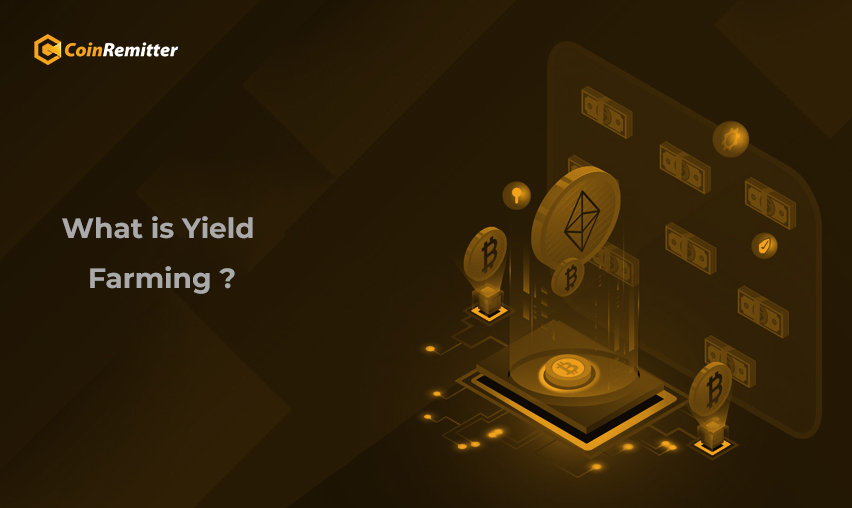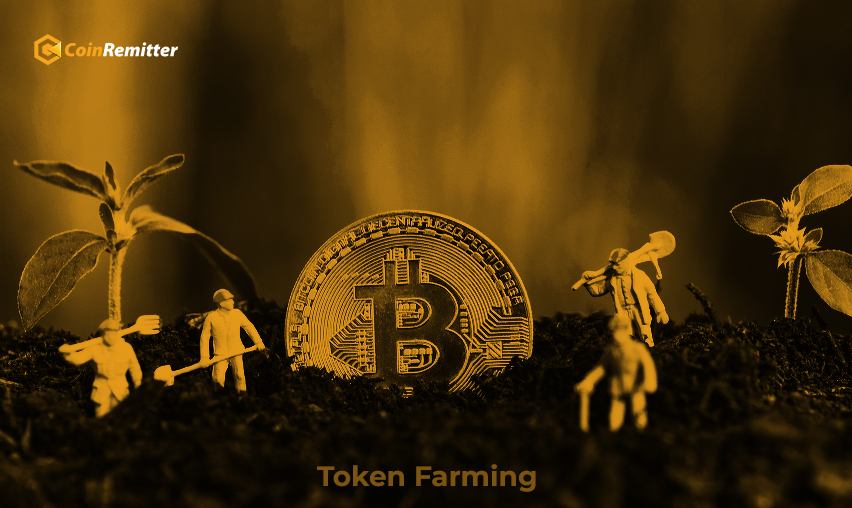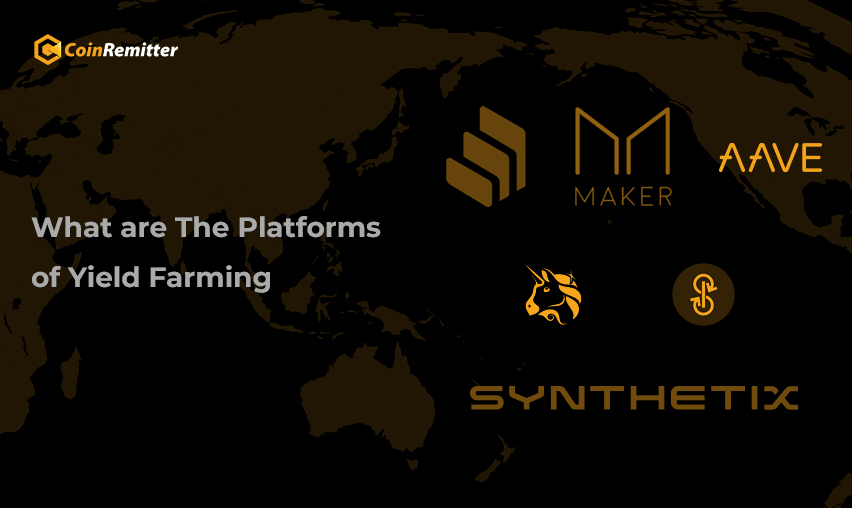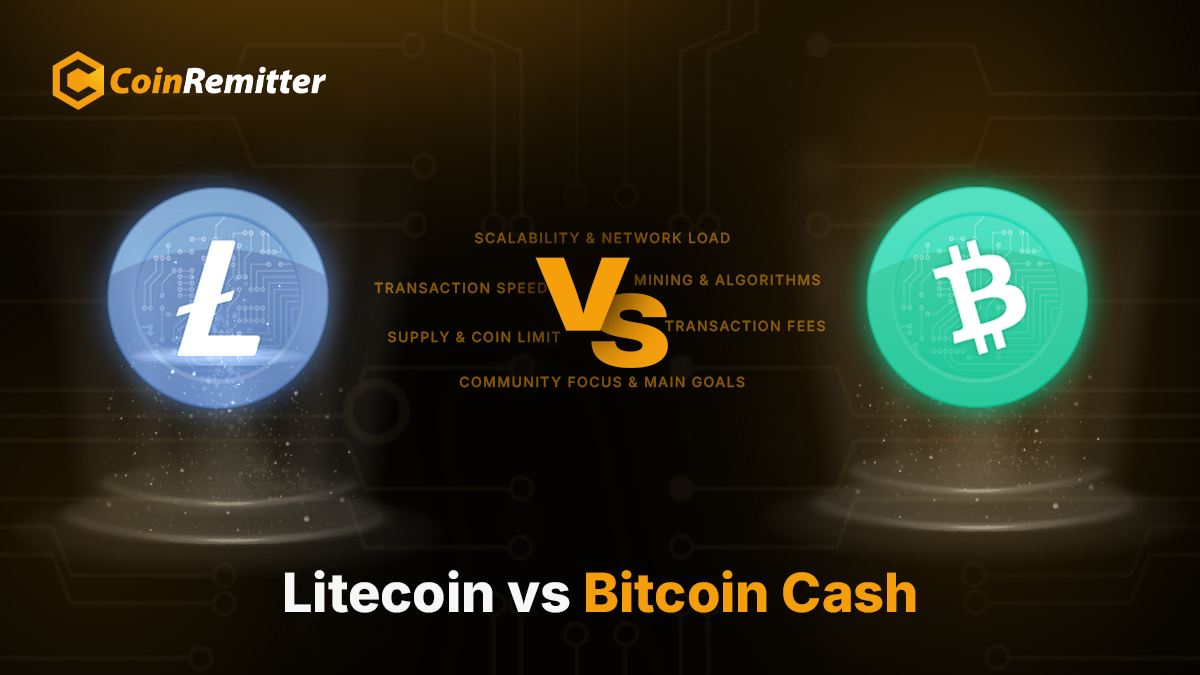Yield Farming in DeFi: Everything You Need to Know

Yield Farming currently becomes a hot topic in the crypto world. Those who have a good understanding of Defi are possibly also acquainted with the Yield farming.
To simply understand, yield Farming is the method of efficient use of crypto tokens in a decentralized finance (DeFi) market in order to gain interest.
It is one of DeFi’s popular solutions that enable investors to get an interest in lending their tokens out.
With yield farming, one can generate passive income with that. One thing to note that, yield farming occurs on the Ethereum blockchain.
Let’s drive straight on the aspects of the Yield Farming.
What is Yield Farming?

The idea of yield farming has emerged from the decentralized finance division.
Understand Yield farming with the example of a bank. There is a purpose of gaining interest when you deposit your money to the bank.
The same goes for Yield farming, you can staking or locking up the cryptocurrencies in order to get a reward in return.
The basic concept is that people can earn a significant amount of tokens and in return for their involvement in DeFi applications.
Moreover, yield farming is also similar to liquidity mining. On top of that, yield farming can be correlated with staking.
In the background, though, there’s a lot of uncertainty going on. In some ways, it deals with users called liquidity providers (LP) who add funds to liquidity pools.
Now you may have wondered what the liquidity pool is?
SO basically the liquidity pool is a smart contract that contains funds.
LPs get a reward in return for adding liquidity to the pool. This reward may come from fees that the underlying DeFi network, or some other source.
Yield farming is normally done on Ethereum using ERC-20 tokens, and the rewards that genrated are also a form of an ERC-20 token.
Why Yield Farming is Currently The Hot Topic?

There are several reasons for this, such as in the midst of the Covid-19 pandemic, that all cryptocurrencies are generally seen in the long term as a non-correlated asset.
In addition, it has also seen an increase in interest in many traditional assets in the light of high volatility.
Moreover, The launch of the COMP token, the governance token of the Compound Finance ecosystem can be attributed to a sudden strong interest in yield farming.
Tokens of governance give privileges of governance to token holders. But if you want to keep the network as decentralized as possible, how do you distribute those tokens?
There is a way with a decentralized blockchain is distributing these governance tokens algorithmically, with liquidity rewards.
SO, this draws providers of liquidity to plant the new token by supplying the liquidity to the protocol.
The Types of Yield Farming

There are basically several ways in which users can begin farming new protocol tokens.
It all started with the token Compound when the users can easily convert their USDT to USD and then place it on Balancer to help the Automatic Market Maker for traders.
Moreover, protocols have been innovating new ways to optimize the yield for their users.
Currently, you are part of a major experiment that AIMED at eliminating intermediaries from financial transactions.
Token Farming

There are specific protocols that incentivize liquidity providers with fees, also some add the new flavor to the equation by adding a giveaway of protocol tokens as well.
Users can get a chance to earn NATIVE tokens from yEarn and Compound protocols but after giving liquidity to the pools.
The reward rate appears to be greater when the pool has less quantity, and hence draws more and more “farmers.”
Moreover, to start farming the protocol’s tokens, users need to add a collection of tokens to pools on Uniswap and then stake the Uniswap tokens on the network.
Each protocol using a different approach to reward its users. Many have different use cases for their tokens for the network as well.
How To Calculate Yield Farming returns?

The returns on yield farming calculated annually. It forecasts the returns that you might expect over the course of a year.
Annual Percentage Yield (APY) and Annual Percentage Rate (APR) these two are common matrics.
The distinction between them is that the IMPACT of compounding is not taken into consideration by APR, whereas the APY does.
If we talk about compounding, it means reinvesting profits directly to produce more returns. It is advisable, although, to be aware of APR and APY because they can be used interchangeably.
One thing to note is that these are only estimations and predictions. Short-term rewards are pretty tough to figure out accurately.
Why is this difference? because the market of yield farming is fast-paced and it is highly competitive as well. On top of that, the rewards also can fluctuate quickly.
Suppose that the strategy of yield farming works just for a while, there are many farmers who are ready to jump for the opportunity and the chances that it will stop yielding high returns.
What are The Platforms of Yield Farming?

There is no set plan for yield farming strategies, it may change by the hour.
Before you step into yield farming, you should have an idea of how decentralized liquidity protocols operate.
Because every platform and plan will have its own guidelines and risks.
The fundamental principle is to invest funds into a smart contract and receive rewards in return.
A nice piece of advice is not to deposit blindly in order to hope for a high return. You need to have a good understanding of risk management.
BELOW are some of the best yield farming platforms that need to be considered.
Compound Finance:
The compound is a money market algorithm that enables users to loan and borrow funds.
Now you can earn interest straight and easily, all you need is the ethereum wallet and an adequate amount of funds.
The compound is the first among the other platforms that come to provide support for Yield Farming.
Aave:
Aave is yet another protocol that offers lending and borrowing token.
It is a system of smart contracts that operating on the Ethereum blockchain, which enables these assets to be operated by a distributed network of computers operating its software.
The tokens lent instantly begin to earn interest.
Aave’s other feature is flash loans, which enables users to borrow any amount of capital if it is repaid in the same deal, helping to seize immense opportunities for arbitration.
MakerDAO:
MakerDao is a decentralized lending facility built on the Ethereum blockchain.
Maker is a decentralized credit network that supports the development of DAI, an algorithmic stable coin linked to the USD value.
Users may open a Maker Vault where they lock the collateral assets like ETH, BAT, USDC, or WBTC. Moreover, They can produce DAI as a debt against this locked collateral.
Over time, this debt incurs interest that referred to as stability tax, whose rate is determined by MKR token holders.
Uniswap:
Uniswap is a crypto exchange that is based on Ethereum to allows everyone to swap ERC20 tokens.
To create demand, liquidity providers deposit the equal value of two tokens. Then traders will sell against the pool of liquidity.
Liquidity providers receive fees from trades that happen in their pool in exchange for providing liquidity.
Many platforms designed to work with yield farming strategies that enable users to add liquidity to the pools and then stake those LP tokens for yield farming.
Synthetix:
Synthetix is a protocol for synthetic assets. This enables everyone to lock up Synthetix Network Token (SNX) or ETH as collateral against it and mint synthetic properties.
Talking about the asset. Then it is something with a stable feed rate.
However, This allows the Synthetix platform to be applied to almost every financial asset. Virtually everything can be used as a yield-farming commodity.
Yearn.finance:
Yearn.finance is a shared aggregator ecosystem for loan services like Aave, Compound, and others.
It aims at optimizing token lending by identifying the most profitable lending services algorithmically.
Upon depositing the periodic rebalance to maximize benefit, funds are converted to yTokens.
Moreover, Yearn.finance is beneficial for farmers who want a protocol that selects the best strategies for them automatically.
The Advantages and Risks of yield farming

Last but certainly not least. The advantages of yield farming are instantly obvious: benefit. Yield farmers who are early in adopting a new project will benefit from token incentives that can appreciate value quickly.
They can gain some important gains if they sell certain tokens at the right time. In other DeFi programs, these profits can be reinvested to generate even more yield.
In order to produce any meaningful income, yield farmers typically have to put down a large value of initial money, even hundreds of thousands of dollars could be at stake.
Yield farmers are exposed to a substantial risk of liquidation if the price unexpectedly drops, as it did with HotdogSwap, due to the extremely volatile nature of cryptocurrencies and particularly DeFi tokens.
However, there are risks like yield farmers take chances with the project teams and the smart contract code underlying them.
Many developers and entrepreneurs who bootstrap projects from scratch or even copy their predecessors’ code are attracted by the potential for gains in the DeFi space.
Although, the code is always unaudited, even though the project team is truthful, and could be subject to bugs that make it vulnerable to attackers.
Another RISK is BZx, which endured a number of hacks earlier this year and, most recently, lost an extra $8 million, which was later returned due to a single misplaced code section.
There so many risks like these are around with yield farming.
Conclusion:
So we have covered almost all the questions related to yield farming that you need to know.
DeFi money markets will help build a financial system that is more open and transparent and available to anyone
Let us know about how this yield farming is useful to you and what else do you want to know.
Over 38,000 merchants are using CoinRemitter
Join them now



